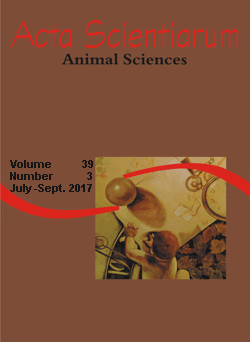<b>Nile tilapia culture under feeding restriction in bioflocs and bioflocs plus periphyton tanks
Resumo
Intensive aquaculture systems may cause pollution in water bodies because their effluents have high levels of nutrients. The use of substrates for periphyton and the manipulation of the C: N ratio of water are technologies that can be employed to increase aquaculture yield with environmental sustainability. The present study has aimed at determining whether feeding restriction could stimulate a greater use of natural food in three different Nile tilapia rearing systems (green water, bioflocs and biophyton), without growth performance impairment. There were nine treatments with four replicates each one (36 experimental units). The animals were raised in conventional (green water) tanks, C: N-ratio adjusted tanks (bioflocs) and bioflocs + periphyton integrated tanks (biophyton). In each culture system, the artificial diet was delivered regularly or under two levels of restriction (15 and 30%). In conventional tanks, fish growth performance was reduced by feeding restriction. Ammonia and nitrite were reduced in bioflocs tanks. Underwater structures for periphyton were not able to increase ammonia and nitrite removal. In bioflocs tanks, feeding restriction of 15% did not lessen fish weigh gain. Underwater structures for periphyton have not improved fish growth performance in any aspect.
Downloads
DECLARAÇÃO DE ORIGINALIDADE E DIREITOS AUTORAIS
Declaro que o presente artigo é original, não tendo sido submetido à publicação em qualquer outro periódico nacional ou internacional, quer seja em parte ou em sua totalidade.
Os direitos autorais pertencem exclusivamente aos autores. Os direitos de licenciamento utilizados pelo periódico é a licença Creative Commons Attribution 4.0 (CC BY 4.0): são permitidos o compartilhamento (cópia e distribuição do material em qualqer meio ou formato) e adaptação (remix, transformação e criação de material a partir do conteúdo assim licenciado para quaisquer fins, inclusive comerciais.
Recomenda-se a leitura desse link para maiores informações sobre o tema: fornecimento de créditos e referências de forma correta, entre outros detalhes cruciais para uso adequado do material licenciado.








































